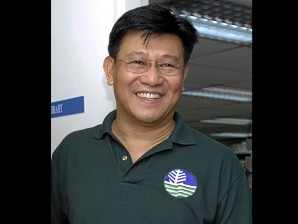
Environment Secretary Ramon Paje
MANILA, Philippines — That noxious smell in the air? That’s the scent of the New Year in the city.
Metro Manila residents woke up – some coughing and sneezing – to a city that was enveloped by dense, dirty, toxic air in the morning after the New Year revelries filled with firecracker explosions and smoke.
The data were so alarming that Environment Secretary Ramon Paje has reiterated his call for a ban on firecrackers in future New Year celebrations.
Data from the Department of Environment and Natural Resources (DENR) showed on Sunday that the measurement of the total suspended particles in the city’s air, which is unclean to begin with, went through the roof, thanks to the firecracker explosions that greeted 2012.
The smog that covered the city had prompted airport officials to divert planes landing in Manila to Clark airport in Pampanga due to poor visibility over the metropolis.
According to Director Bobby Sheen of the DENR – National Capital Region, air pollution measuring stations located in Katipunan, Quezon City, Valenzuela City, and at the National Mapping and Resource Information Authority (Namria) in Taguig showed the highest TSP readings between 800-1000 micrograms per normal cubic meter.
The maximum readings were recorded just before 12 mn and in the early hours of January 1, just when the contaminants like sulfur, potassium, and carbon particulates were settling over the city.
The highest TSP level at the NAMRIA station, which is closest to the Ninoy Aquino International Airport (NAIA), was recorded at 950 µg/Ncm. between 4-5 am of Jan. 1.
The worst TSP reading at the Valenzuela station was registered at 886 µg/Ncm just before midnight.
The station located at the Ateneo de Manila University in Katipunan showed a maximum TSP reading of 992 µg/Ncm, taken between 3-4 am of Jan. 1.
For comparison, Metro Manila’s average TSP in the third quarter of 2011 was measured at 116 µg/Ncm. Although the pollution level has declined since 2010, the city’s air is still considered dirty. The World Health Organization’s standard of clean air is 90 µg/Ncm.
Environment Secretary Ramon Paje, who had asked local government units to limit firecracker use for the new year celebrations, renewed his call to ban it starting the next New Year celebration
Paje explained that air pollution usually worsened during the year-end holidays because of the massive use of fireworks to welcome the new year.
“It has not only set back our efforts against air pollution, but also poses danger to life and limb. It also puts the airline industry into great risks, causing the diversion of today’s NAIA flights to Clark,” Paje said.
He also warned that the air pollution could bring respiratory problems to Metro Manila residents.
“Air pollution is a health hazard. Our health department has been very vocal about it that it particularly impact on our children and senior citizens because of their fragile health condition,” Paje had said previously.
Sheen said the pollution level would normalize in a week, depending on the weather and winds. He noted that rains and strong winds could help dissipate the toxic gases in the air.
Traditionally, motor vehicles were the main source of pollution in the metropolis, accounting for as much as 80 percent of the pollution. The rest comes from industrial sources.